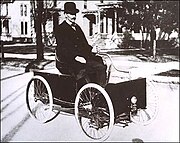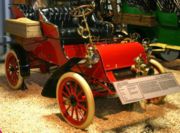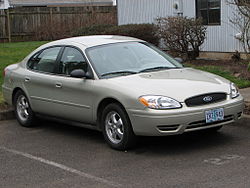
 Ford Motor Company is an American multinational corporation and the world's third largest automaker based on vehicle sales in 2005. Based in Dearborn, Michigan, a suburb of Detroit, the automaker was founded by Henry Ford and incorporated in 1903. Ford now encompasses many global brands, including Lincoln and Mercury of the US, Jaguar and Land Rover of the UK, and Volvo of Sweden. Ford also owns a one-third controlling interest in Mazda.
Ford Motor Company is an American multinational corporation and the world's third largest automaker based on vehicle sales in 2005. Based in Dearborn, Michigan, a suburb of Detroit, the automaker was founded by Henry Ford and incorporated in 1903. Ford now encompasses many global brands, including Lincoln and Mercury of the US, Jaguar and Land Rover of the UK, and Volvo of Sweden. Ford also owns a one-third controlling interest in Mazda.
Ford was launched in a converted factory in 1903 with $28,000 in cash from twelve investors, most notably John Francis Dodge and Horace Elgin Dodge who would later found the Dodge Brothers Motor Vehicle Company. Henry Ford was 40 years old when he founded the Ford Motor Company, which would go on to become one of the largest and most profitable companies in the world, as well as being one of the few to survive the Great Depression. The largest family-controlled company in the world, the Ford Motor Company has been in continuous family control for over 100 years.
 During its early years, the company produced a range of vehicles designated, chronologically, from the Model A in 1903 to the Model S in 1908. That year, Henry Ford introduced the Model T. Earlier models were produced at a rate of only a few a day at a rented factory on Mack Avenue in Detroit, Michigan with groups of two or three men working on each car from components made to order by other companies. The first Model T's were built at the Piquette Road Manufacturing Plant, the first company-owned factory. In its first full year of production, 1909, about 18,000 Model Ts were built. As demand for the car grew, the company moved production to the much larger Highland Park Plant, and in 1911, the first year of operation there, about 70,000 Model Ts were produced. By 1913, the company had developed all of the basic techniques of the assembly line and mass production. Ford introduced the world's first moving assembly line that year, which reduced chassis assembly time from 12½ hours in October to 2 hours, 40 minutes, and boosted annual output to 250,000 units (by 1920, this figure would exceed one million!). However, these innovations were hard on employees, and turnover of workers was very high. Turnover meant delays and extra costs of training, and use of slow workers. In January 1914, Ford solved the employee turnover problem by doubling pay to $5 a day ($103 per day in 2006 dollars), cutting shifts from nine hours to an eight hour day for a 5 day work week, and instituting hiring practices that identified the best workers. Thus, it pioneered the minimum wage and the 40 hour work week in the United States, before the government enacted it.
During its early years, the company produced a range of vehicles designated, chronologically, from the Model A in 1903 to the Model S in 1908. That year, Henry Ford introduced the Model T. Earlier models were produced at a rate of only a few a day at a rented factory on Mack Avenue in Detroit, Michigan with groups of two or three men working on each car from components made to order by other companies. The first Model T's were built at the Piquette Road Manufacturing Plant, the first company-owned factory. In its first full year of production, 1909, about 18,000 Model Ts were built. As demand for the car grew, the company moved production to the much larger Highland Park Plant, and in 1911, the first year of operation there, about 70,000 Model Ts were produced. By 1913, the company had developed all of the basic techniques of the assembly line and mass production. Ford introduced the world's first moving assembly line that year, which reduced chassis assembly time from 12½ hours in October to 2 hours, 40 minutes, and boosted annual output to 250,000 units (by 1920, this figure would exceed one million!). However, these innovations were hard on employees, and turnover of workers was very high. Turnover meant delays and extra costs of training, and use of slow workers. In January 1914, Ford solved the employee turnover problem by doubling pay to $5 a day ($103 per day in 2006 dollars), cutting shifts from nine hours to an eight hour day for a 5 day work week, and instituting hiring practices that identified the best workers. Thus, it pioneered the minimum wage and the 40 hour work week in the United States, before the government enacted it.
 Productivity soared and employee turnover plunged, and the cost per vehicle plummeted. Ford cut prices again and again and invented the system of franchised dealers who were loyal to his brand name. Wall Street had disagreed with Ford's generous labor practices when he began paying workers enough to buy the products they made.
Productivity soared and employee turnover plunged, and the cost per vehicle plummeted. Ford cut prices again and again and invented the system of franchised dealers who were loyal to his brand name. Wall Street had disagreed with Ford's generous labor practices when he began paying workers enough to buy the products they made.
By the end of 1919, Ford was producing 50 percent of all cars in the United States, and by 1920 half of all cars in the country were Model Ts. Henry Ford is reported to have said, "Any customer can have a car painted any color that he wants so long as it is black." This was because black paint was quickest to dry; thus assembly time was cut down. Earlier models had been available in a variety of colors.
 In 1915, Henry Ford went on a peace mission to Europe aboard a ship, joining other pacifists in efforts to stop World War I. This led to an increase in his personal popularity. Ford would subsequently go on to support the war effort with the Model T becoming the underpinnings for allied military vehicles.
In 1915, Henry Ford went on a peace mission to Europe aboard a ship, joining other pacifists in efforts to stop World War I. This led to an increase in his personal popularity. Ford would subsequently go on to support the war effort with the Model T becoming the underpinnings for allied military vehicles.
The Ford oval trademark was first introduced in 1907. The 1928 Model A was the first vehicle to sport an early version of the Ford script in the oval badge. The dark blue background of the oval is known to designers as Pantone 294C, the same color used in Finland's flag. The Ford script is credited to Childe Harold Wills, Ford's first chief engineer and designer. He created a script in 1903 based on the one he used for his business cards. Today, the oval has evolved into a perfect oval with a width-to-height ratio of 8:3. The current Centennial Oval was introduced on June 17, 2003 as part of the 100th anniversary of Ford Motor Company.
 In 1919, Edsel Ford succeeded his father as president of the company, although Henry Ford still kept a hand in management. Although prices were kept low through highly efficient engineering, the company used an old-fashioned personalized management system, and neglected consumer demand for upscale vehicles. It steadily lost market share to GM and Chrysler, as these and other domestic and foreign competitors began offering fresher automobiles with more innovative features and luxury options. GM had a range of models from relatively cheap to luxury, tapping all price points in the spectrum, while less wealthy people purchased used Model Ts. The competitors also opened up new markets by extending credit for purchases, so consumers could buy these expensive automobiles with monthly payments. Ford initially resisted that approach, insisting that such debts would ultimately hurt the consumer and the general economy. Ford eventually relented and started offering the same terms in December 1927, when Ford unveiled the redesigned Model A, and retired the Model T after producing 15 million of them.
In 1919, Edsel Ford succeeded his father as president of the company, although Henry Ford still kept a hand in management. Although prices were kept low through highly efficient engineering, the company used an old-fashioned personalized management system, and neglected consumer demand for upscale vehicles. It steadily lost market share to GM and Chrysler, as these and other domestic and foreign competitors began offering fresher automobiles with more innovative features and luxury options. GM had a range of models from relatively cheap to luxury, tapping all price points in the spectrum, while less wealthy people purchased used Model Ts. The competitors also opened up new markets by extending credit for purchases, so consumers could buy these expensive automobiles with monthly payments. Ford initially resisted that approach, insisting that such debts would ultimately hurt the consumer and the general economy. Ford eventually relented and started offering the same terms in December 1927, when Ford unveiled the redesigned Model A, and retired the Model T after producing 15 million of them.
 On February 4, 1922 Ford expanded its reach into the luxury auto market through its acquisition of the Lincoln Motor Company, named for Abraham Lincoln whom Henry Ford admired, and the Mercury division was established in 1938 to serve the mid-price auto market.[2] Ford Motor Company built the largest museum of American History in 1928, The Henry Ford.
On February 4, 1922 Ford expanded its reach into the luxury auto market through its acquisition of the Lincoln Motor Company, named for Abraham Lincoln whom Henry Ford admired, and the Mercury division was established in 1938 to serve the mid-price auto market.[2] Ford Motor Company built the largest museum of American History in 1928, The Henry Ford.
Henry Ford would go on to acquire Abraham Lincoln's chair, which he was assainated in, from the owners of the Ford Theatre. Washington, D.C. Abraham Lincoln's chair would be displayed along with John F. Kennedy's Lincoln limousine in the Henry Ford Museum & Greenfield Village in Dearborn, known today as The Henry Ford. John F. Kennedy's Lincoln Limousine was leased to the White House by Ford.

 President Franklin Roosevelt referred to Detroit as the "Arsenal of Democracy." The Ford Motor Company played a pivotal role in the allied victory during World War I and World War II. As a pacifist, Henry Ford had expressed that war was a waste of time, Ford did not want to profit from it. Henry Ford was concerned that the Nazis during the 1930s might nationalize his factories in Germany. During the Great Depression Ford's wages may have seen great to his employees but many of the rules of the factories were very harsh and strict. Those were tense times for American companies doing business in Europe. In the spring of 1939, the Nazis assumed day to day control of Ford factories in Germany. With Europe under siege, Henry Ford's genius would be turned to mass production for the war effort. Specifically, the B-24 Liberator bomber, still the most produced allied bomber in history, quickly shifted the balance of power in favor of the allies. The aviation industry could produce, if everything went alright, one Consolidated Aircraft B-24 Bomber a day at an aircraft plant. Ford would show the world how to produce one B-24 an hour at a peak of 600 per month in 24 hour shifts. Ford's Willow Run factory broke ground in the April of 1941. At the time, it was the largest assembly line in the world, with over 3,500,000 square feet (330,000 m²). Edsel Ford, Henry Ford's son, under severe stress of running the B-24 bomber facility, died in the Spring of 1943 of stomach cancer prompting his grieving father Henry Ford to re-assume day-to-day control of the Ford Motor Company. Mass production of the B-24 began by August of 1943. Many pilots slept on cots waiting for takeoff as the B-24 rolled off the assembly line at Ford's Willow Run facility.
President Franklin Roosevelt referred to Detroit as the "Arsenal of Democracy." The Ford Motor Company played a pivotal role in the allied victory during World War I and World War II. As a pacifist, Henry Ford had expressed that war was a waste of time, Ford did not want to profit from it. Henry Ford was concerned that the Nazis during the 1930s might nationalize his factories in Germany. During the Great Depression Ford's wages may have seen great to his employees but many of the rules of the factories were very harsh and strict. Those were tense times for American companies doing business in Europe. In the spring of 1939, the Nazis assumed day to day control of Ford factories in Germany. With Europe under siege, Henry Ford's genius would be turned to mass production for the war effort. Specifically, the B-24 Liberator bomber, still the most produced allied bomber in history, quickly shifted the balance of power in favor of the allies. The aviation industry could produce, if everything went alright, one Consolidated Aircraft B-24 Bomber a day at an aircraft plant. Ford would show the world how to produce one B-24 an hour at a peak of 600 per month in 24 hour shifts. Ford's Willow Run factory broke ground in the April of 1941. At the time, it was the largest assembly line in the world, with over 3,500,000 square feet (330,000 m²). Edsel Ford, Henry Ford's son, under severe stress of running the B-24 bomber facility, died in the Spring of 1943 of stomach cancer prompting his grieving father Henry Ford to re-assume day-to-day control of the Ford Motor Company. Mass production of the B-24 began by August of 1943. Many pilots slept on cots waiting for takeoff as the B-24 rolled off the assembly line at Ford's Willow Run facility.
At the behest of Edsel Ford's widow Eleanor and Henry's wife Clara, Henry Ford would make his oldest grandson, Henry Ford II, President of Ford Motor Company.
Henry Ford II served as President from 1945–1960, and as Chairman and CEO from 1960–1980. "Hank the Deuce" led Ford to become a publicly traded corporation in 1956. However, the Ford family maintains about 40 percent controlling interest in the company, through a series of Special Class B preferred stocks.
In 1947, Henry Ford passed away. According to A&E Biography, an estimated 7 million people mourned his death.
Ernest Breech was hired in 1946 and became the Executive Vice President. Then later became Board Chairman in 1955.
In 1946 Robert McNamara joined Ford Motor Company as manager of planning and financial analysis. He advanced rapidly through a series of top-level management positions to the presidency of Ford on 9 November 1960, one day after John F. Kennedy's election. The first company head selected outside the Ford family, McNamara had gained the favor of Henry Ford II, and had aided in Ford's expansion and success in the postwar period. Less than five weeks after becoming president at Ford, he accepted Kennedy's invitation to join his cabinet, as Secretary of Defense.
In the 1950s, Ford introduced the iconic Thunderbird in 1955 and the Edsel brand automobile line in 1958. Edsel was cancelled after less than 27 months in the marketplace in November 1960. The corporation bounced back from the failure of the Edsel by introducing its compact Ford Falcon in 1960 and the Mustang in 1964. By 1967, Ford of Europe was established.
 Lee Iacocca was involved with the design of several successful Ford automobiles, most notably the Ford Mustang. He was also the "moving force," as one court put it, behind the notorious Ford Pinto. He promoted other ideas which did not reach the marketplace as Ford products. Eventually, he became the president of the Ford Motor Company, but he clashed with Henry Ford II and ultimately, on July 13, 1978, he was famously fired by Henry II, despite Ford posting a $2.2 billion dollar profit for the year. In 1979 Phil Caldwell became Chairman, succeeded in 1985 by Don Petersen
Lee Iacocca was involved with the design of several successful Ford automobiles, most notably the Ford Mustang. He was also the "moving force," as one court put it, behind the notorious Ford Pinto. He promoted other ideas which did not reach the marketplace as Ford products. Eventually, he became the president of the Ford Motor Company, but he clashed with Henry Ford II and ultimately, on July 13, 1978, he was famously fired by Henry II, despite Ford posting a $2.2 billion dollar profit for the year. In 1979 Phil Caldwell became Chairman, succeeded in 1985 by Don Petersen
Harold Poling served as Chairman and CEO from 1990-1993. Alex Trotman was Chairman and CEO from 1993-1998, and Jacques Nasser served at the helm from 1999-2001. Henry Ford's great-grandson, William Clay Ford Jr., is the company's current Chairman of the Board and was CEO until September 5, 2006, when he named Alan Mulally from Boeing as his successor. As of 2006, the Ford family owns about 5 percent of Ford's shares and controls about 40 percent of the voting power through a separate class of stock.
In December 2006, Ford announced that it would mortgage all assets, including factories and equipment, office property, intellectual property (patents and trademark), and its stakes in subsidiaries, to raise $23.4 billion in cash. The secured credit line is expected to finance product development during the restructuring through 2009, as the company expects to burn through $17 billion in cash before turning a profit. The action was unprecedented in the company's 103 year history.
(http://www.bmw-forums.net/ford.html)